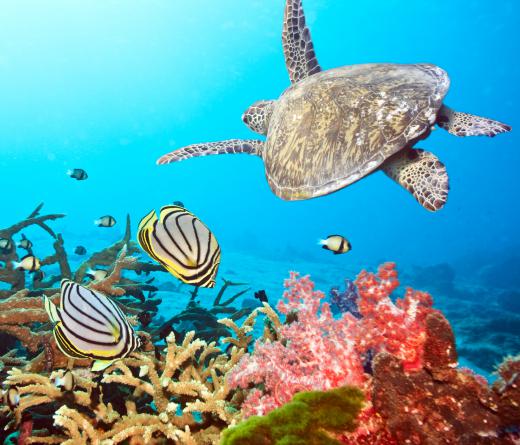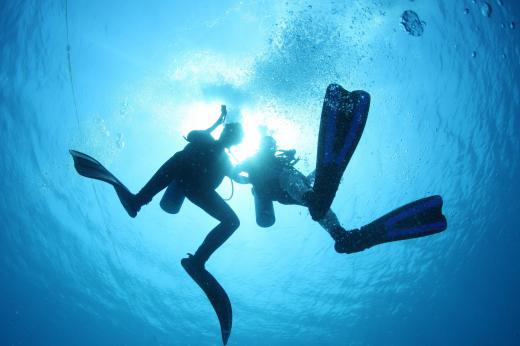What are the Different Layers of the Ocean?
 Michael Anissimov
Michael Anissimov
Open ocean, significantly distant from the continental shelves, is collectively known as the pelagic zone of the ocean. The name is derived from the Greek pélagos which means "open ocean". The pelagic zone is divided into five sub-zones of increasing depth: the epipelagic zone, mesopelagic zone, bathypelagic zone, abyssoplegic zone, and — reserved for deep sea trenches only — the hadeoplegic zone.
The epipelagic zone extends from the surface down to 200 meters (656 ft), and is the brightest of the zones (and one of the only two with much light at all). This is where most of the familiar creatures of the sea hang out, like much of the fish we eat and the coral reefs which catch our ships by surprise. The area is rich with photosynthesizing microorganisms, which are consumed by larger organisms all the way up the food chain to creatures like sharks. The name "epipelagic" roughly means "top zone of the ocean."

The mesopelagic zone (from 200 m down to around 1,000 m or 3,280 feet) is the twilight zone. The name roughly means "middle of the ocean". The biodensity here is less than that of the epipelagic zone above because the light penetration rapidly drops off in the lower regions of this zone. Collectively, the epipelagic and top of the mesopelagic zones are known as the photic zone, meaning light gets to them. Semi-deep sea creatures such as the Swordfish and Wolf Eels live here.

The bathypelagic zone extends from 1,000 m underwater to around 4,000 m (13,123 feet) underwater. Very little light reaches this depth, and as such no living plants can be found here. The deep sea animals which live here are adapted to consuming the snow of organic detritus that continually falls from above. Giant and Colossal Squid can be found here, as well as sperm whales.

The deepest zones are the abyssopelagic and hadeopelagic, meaning "bottomless ocean" and "hellish ocean" respectively. The abyssopelagic receives no light whatsoever, and is the region located deeper than 4,000 m underwater. Bottom-feeders live here, many of which have scoop-shaped jaws to lift detritus from the ocean floor. The very bottom of the oceans tends to be filled with a layer of organic muck a few inches in depth, like a forest floor. Very little is known about these regions, however, as only the hardiest deep-diving robots can make it down here.
AS FEATURED ON:
AS FEATURED ON:















Discussion Comments
I recommend you add more information on ocean life.
A little over 1 million species on Earth have so far been identified. Scientists estimate there may be an additional 6 miilion+ species as yet to be discovered. The majority of these as yet identified species will most certainly be found in the ocean as less than 5 percent of the ocean/ocean floor has been surveyed. We literally know more about the surface of the moon than we do about the our own oceans.
I am a simple man, and have come to believe our oil is made at the lowest ocean levels. These immense pressures and the presence of "muck" has made me believe oil is constantly being made and pressed into cavities which eventually become oil wells.
I have a brother in Alaska who tells me the wells there can go dry and after a few years will again begin producing, so the earth is constantly making hydrocarbons. Perhaps we are doing the environment a favor by fueling our lives with them.
@Domido - I find that information about some of the underwater animals glowing to be quite interesting. There is another possibility, though.
When I was a child, my parents took my older sister and me to the Blue Ridge Parkway for vacation. While we were there, we went to an immense underground cavern.
It was beautiful, and really very scary. One of the scariest things was the fish. You could look into all of these underground rivers from bridges and ridges. The fish were absolutely gigantic, and they all had white eyes.
They were able to grow that large because for hundreds, or possibly even thousands of years, they were completely unfished and more or less trapped in this underground haven.
Their eyes were white because they were all blind. Since they were always without light, their bodies adapted to this and they no longer had the sense of sight.
I wonder if this is how the creatures of the lesser known areas of the ocean trench are. Blind, and huge!
If so, I wonder how their other senses have adapted to take over for their loss of vision and what quantities of food must be available to them for their survival.
I have always found the ocean to be incredibly and completely mesmerizing. It is very unknown to us, much like space.
And, as a result, it isn’t anything particularly new to hear that there has been a new species found in the lower layers of the ocean.
I think that these kinds of ocean facts are not only amazing, but also awe inspiring. I’ve heard that there are actually animals down in those lower layers that glow – sort of like a glow stick – and that that is how they recognize each other.
Can you imagine what kinds of creatures could be there? Can you just imagine how all of the sea monsters and merpeople of old could actually be living in the lowest depths of the ocean? I like to think so, myself, as a somewhat fairytale oriented individual.
One day we might know what actually is in the bottommost regions; but in a lot of ways, I hope it isn’t in my lifetime. It’s good to have something that is still a mystery, isn’t it?
The question refers to water bodies
Moving vertically down the depth, are there different layers in which the current moves in different directions? What is the reason?
Post your comments